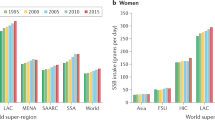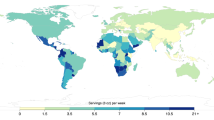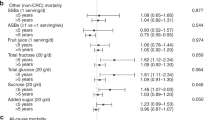Abstract
Background
In 2010, sugar sweetened beverages (SSBs) were estimated to cause 12% of all diabetes, cardiovascular disease (CVD) and obesity-related cancer deaths in Mexico. Using new risk estimates for SSBs consumption, we aimed to update the fraction of Mexican mortality attributable to SSBs, and provide subnational estimates by region, age, and sex.
Methods
We used an established comparative risk assessment framework. All-cause mortality estimates were calculated from a recent pooled cohort analysis. Age- and sex-specific relative risks for SSBs-disease relationships were obtained from updated meta-analyses. Demographics and nationally representative estimates of SSBs intake were derived from the National Health and Nutrition Survey 2012; and mortality rates, from the National Institute of Statistics and Geography. Attributable mortality was calculated by estimating the population attributable fraction of each disease, with uncertainty in data inputs propagated through Monte Carlo probabilistic sensitivity analyses.
Results
In Mexican adults 20 years and older, 6.9% (95%UI: 5.4–8.5) of all cause-mortality was attributable to SSBs, representing 40,842 excess deaths/year (95%UI: 31,950–50,138). Furthermore, 19% of diabetes, CVD and obesity-related cancer mortality was attributable to SSBs (95%UI: 11.0–26.5), representing 37,000 excess deaths/year (95%UI 21,240–51,045). Of these, 35.6% were diabetes-related (95%UI 16.4–52.0). Proportional burden was highest in the South (22.8%), followed by the Center (18.0%) and North (17.4%). Men aged 45–64-years in the Center region had highest proportional mortality (37.2%), followed by 20–44-year-old men living in the South (35.7%) and both men and women aged 20–44 living in the Center (34.4%).
Conclusions
Utilizing current evidence linking SSBs to cardiometabolic disease and obesity-related cancers, earlier estimates of Mexican mortality attributable to SSBs could have been underestimated. Mexico urgently needs stronger policies to reduce SSBs consumption and reduce these burdens.
This is a preview of subscription content, access via your institution
Access options
Subscribe to this journal
Receive 12 print issues and online access
$259.00 per year
only $21.58 per issue
Buy this article
- Purchase on Springer Link
- Instant access to full article PDF
Prices may be subject to local taxes which are calculated during checkout
Similar content being viewed by others
Change history
15 March 2024
A Correction to this paper has been published: https://doi.org/10.1038/s41366-024-01498-3
References
Malik VS, Popkin BM, Bray GA, Despres JP, Hu FB. Sugar-sweetened beverages, obesity, type 2 diabetes mellitus, and cardiovascular disease risk. Circulation. 2010;121:1356–64.
Singh GM, Micha R, Khatibzadeh S, Lim S, Ezzati M, Mozaffarian D, et al. Estimated global, regional, and national disease burdens related to sugar-sweetened beverage consumption in 2010. Circulation. 2015;132:639–66.
Hu FB, Malik VS. Sugar-sweetened beverages and risk of obesity and type 2 diabetes: epidemiologic evidence. Physiol Behav. 2010;100:47–54.
Imamura F, O'Connor L, Ye Z, Mursu J, Hayashino Y, Bhupathiraju SN, et al. Consumption of sugar sweetened beverages, artificially sweetened beverages, and fruit juice and incidence of type 2 diabetes: systematic review, meta-analysis, and estimation of population attributable fraction. Brit Med J. 2015;351:h3576.
Micha R, Shulkin ML, Penalvo JL, Khatibzadeh S, Singh GM, Rao M, et al. Etiologic effects and optimal intakes of foods and nutrients for risk of cardiovascular diseases and diabetes: Systematic reviews and meta-analyses from the Nutrition and Chronic Diseases Expert Group (NutriCoDE). PLoS ONE 2017;12:e0175149.
Xi B, Huang Y, Reilly KH, Li S, Zheng R, Barrio-Lopez MT, et al. Sugar-sweetened beverages and risk of hypertension and CVD: a dose-response meta-analysis. Br J Nutr. 2015;113:709–17.
Institute for Health Metrics and Evaluation. Global burden of diseases, risk factors, and injuries 2010 study. USA: University of Washington; 2010.
WHO. Guideline: sugars intake for adults and children. Geneva: WHO; 2015.
Euromonitor International. Euromonitor international’s passport global market. UK: Euromonitor International; 2012.
Singh GM, Micha R, Khatibzadeh S, Shi P, Lim S, Andrews KG, et al. Global, regional, and national consumption of sugar-sweetened beverages, fruit juices, and milk: a systematic assessment of beverage intake in 187 countries. PLoS ONE 2015;10:e0124845.
Sanchez-Pimienta TG, Batis C, Lutter CK, Rivera JA. Sugar-sweetened beverages are the main sources of added sugar intake in the mexican population. J Nutr. 2016;146:1888S–96S.
Aburto TC, Pedraza LS, Sanchez-Pimienta TG, Batis C, Rivera JA. Discretionary foods have a high contribution and fruit, vegetables, and legumes have a low contribution to the total energy intake of the Mexican population. J Nutr. 2016;146:1881S–7S.
Rojas-Martinez R, Basto-Abreu A, Aguilar-Salinas CA, Zarate-Rojas E, Villalpando S, Barrientos-Gutierrez T. Prevalence of previously diagnosed diabetes mellitus in Mexico. Salud Publica Mex. 2018;60:224–32.
Secretaria de Salud. Dirección General de Evaluación del Demespeño Informe sobre la Salud de los Mexicanos. Mexico: Secretaria de Salud; 2015.
Romero-Martinez M, Shamah-Levi T, Franco-Nuñez A, Villalpando-Hernandez S, Cuevas-Nasu L, Gutierrez JP, et al. National Health and Nutrition Survey 2012 design and coverage. Salud Pública Mex. 2013;55:s332–s40.
Geografía INdEy. Estadística de defunciones generales. Síntesis metodológica. 2014.
Malik VS, Li Y, Pan A, De Koning L, Schernhammer E, Willett WC, et al. Long-term consumption of sugar-sweetened and artificially sweetened beverages and risk of mortality in US adults. Circulation. 2019;139:2113–25.
Khatibzadeh S, Micha R, Afshin A, Rao M, Yakoob MY, Dariush M. Abstract: Major dietary risk factors for chronic diseases: a systematic review of the current evidence for causal effects and effect sizes. Circulation. 2012;125(Suppl10):AP060.
Luger M, Lafontan M, Bes-Rastrollo M, Winzer E, Yumuk V, Farpour-Lambert N. Sugar-sweetened beverages and weight gain in children and adults: a systematic review from 2013 to 2015 and a comparison with previous studies. Obesity Facts. 2017;10:674–93.
Singh GM, Danaei G, Farzadfar F, Stevens GA, Woodward M, Wormser D, et al. The age-specific quantitative effects of metabolic risk factors on cardiovascular diseases and diabetes: a pooled analysis. PLoS ONE 2013;8:e65174.
Renehan AG, Tyson M, Egger M, Heller RF, Zwahlen M. Body-mass index and incidence of cancer: a systematic review and meta-analysis of prospective observational studies. Lancet. 2008;371:569–78.
Taguri M, Matsuyama Y, Ohashi Y, Harada A, Ueshima H. Doubly robust estimation of the generalized impact fraction. Biostatistics. 2012;13:455–67.
Zepeda-Tello R, Camacho-Garcia-Formenti D. Pifpaf: potential impact fraction and population attributable fraction for cross-sectional data. CRAN R Package Documentation. 2017. https://rdrr.io/cran/pifpaf/.
Simin Liu JoAnnE, Manson JulieE, Buring MeirJ, Stampfer WalterC, Willett, Ridker PM. Relation between a diet with a high glycemic load and plasma concentrations of high-sensitivity C-reactive protein in middle-aged women. Am J Clin Nutr. 2002;75:492–8.
Collaboration TGBoMRFfCD. Cardiovascular disease, chronic kidney disease, and diabetes mortality burden of cardiometabolic risk factors from 1980 to 2010: a comparative risk assessment. Lancet Diabetes Endocrinol. 2014;2:634–47.
López-Olmedo N, Popkin BM, Taillie LS. The socioeconomic disparities in intakes and purchases of less-healthy foods and beverages have changed over time in urban Mexico. J Nutr. 2018;148:109–16.
Gómez-Dantés H, Fullman N, Lamadrid-Figueroa H, Cahuana-Hurtado L, Darney B, Avila-Burgos L, et al. Dissonant health transition in the states of Mexico, 1990–2013: a systematic analysis for the Global Burden of Disease Study 2013. Lancet. 2016;388:2386–402.
Salud Sd. Estrategia Nacional para la Prevención y el Control del Sobrepeso, la Obesidad y la Diabetes. Mexico City: Salud Sd; 2013.
Cámara de Diputados del Honorable Congreso de la Union. Ley del impuesto especial sobre producción y servicios. Mexico: Diario Oficial de la Federación; 2016.
Colchero MA, Rivera-Dommarco J, Popkin BM, Ng SW. In Mexico, evidence of sustained consumer response two years after implementing a sugar-sweetened beverage tax. Health Affairs.2017;36:564–71.
Colchero MA, Zavala JA, Batis C, Shamah-Levy T, Rivera-Dommarco JA. Changes in prices of taxed sugar-sweetened beverages and nonessential energy dense food in rural and semi-rural areas in Mexico. Salud Publica Mex. 2017;59:137–46.
Barrientos-Gutierrez T, Zepeda-Tello R, Rodrigues ER, Colchero MA, Rojas-Martinez R, Lazcano-Ponce E, et al. Expected population weight and diabetes impact of the 1-peso-per-litre tax to sugar sweetened beverages in Mexico. PLoS ONE 2017;12:e0176336.
Barrientos-Gutiérrez T, Colchero MA, Sánchez-Romero LM, Batis C, Rivera-Dommarco J. Posicionamiento sobre los impuestos a alimentos no básicos densamente energéticos y bebidas azucaradas. Salud Pública de México; 2018. vol. 60, p. 586.
Basto-Abreu A, Braverman-Bronstein A, Camacho-Garcia-Formenti D, Zepeda-Tello R, Popkin BM, Rivera-Dommarco J, et al. Expected changes in obesity after reformulation to reduce added sugars in beverages: a modeling study. PLoS Med. 2018;15:e1002664.
Kaufer-Horwitz M, Tolentino-Mayo L, Jáuregui A, Sánchez-Bazán K, Bourges H, Martínez S, et al. Sistema de etiquetado frontal de alimentos y bebidas para México: una estrategia para la toma de decisiones saludables. Salud Pública de México. 2018;60:479.
Pérez-Ferrer C, Barrientos-Gutierrez T, Rivera-Dommarco JA, Prado-Galbarro FJ, Jiménez-Aguilar A, Morales-Ruán C. et al. Compliance with nutrition standards in Mexican schools and their effectiveness: a repeated cross-sectional study. BMC Public Health. 2018;18:1411.
Murray CJL, Dias RH, Kulkarni SC, Lozano R, Stevens GA, Ezzati M. Improving the comparability of diabetes mortality statistics in the United States and Mexico. Diabetes Care. 2008;31:451–8.
Hu H, Huff CD, Yamamura Y, Wu X, Strom SS. The relationship between native american ancestry, body mass index and diabetes risk among Mexican-Americans. PLoS ONE 2015;10:e0141260.
Yikyung Park KWD, Kipnis V, Thompson FE, Potischman N, Schoeller DA, Baer DJ, et al. Comparison of self-reported dietary intakes from the automated self-administered 24-h recall, 4-d food records, and food-frequency questionnaires against recovery biomarkers. Am J Clin Nutr. 2018;107:80–93.
Acknowledgements
This paper was funded by the Bloomberg Philanthropies and supported by a grant from the Bill & Melinda Gates Foundation (PI Mozaffarian), and from the National Heart, Lung, and Blood Institute (grant number R00HL124321). Tonatiuh Barrientos was supported by the Lown Scholars program from Harvard University.
Author information
Authors and Affiliations
Corresponding author
Ethics declarations
Conflict of interest
The authors declare that they have no conflict of interest.
Additional information
Publisher’s note Springer Nature remains neutral with regard to jurisdictional claims in published maps and institutional affiliations.
Supplementary information
Rights and permissions
Springer Nature or its licensor (e.g. a society or other partner) holds exclusive rights to this article under a publishing agreement with the author(s) or other rightsholder(s); author self-archiving of the accepted manuscript version of this article is solely governed by the terms of such publishing agreement and applicable law.
About this article
Cite this article
Braverman-Bronstein, A., Camacho-García-Formentí, D., Zepeda-Tello, R. et al. Mortality attributable to sugar sweetened beverages consumption in Mexico: an update. Int J Obes 44, 1341–1349 (2020). https://doi.org/10.1038/s41366-019-0506-x
Received:
Revised:
Accepted:
Published:
Issue Date:
DOI: https://doi.org/10.1038/s41366-019-0506-x
This article is cited by
-
Modelling the impact of sodium intake on cardiovascular disease mortality in Mexico
BMC Public Health (2023)
-
How Could Taxes on Sugary Drinks and Foods Help Reduce the Burden Of Type 2 Diabetes?
Current Diabetes Reports (2023)
-
Soft drink and non-caloric soft drink intake and their association with blood pressure: the Health Workers Cohort Study
Nutrition Journal (2022)
-
The role of sugar-sweetened beverages in the global epidemics of obesity and chronic diseases
Nature Reviews Endocrinology (2022)
-
Associations of psychosocial factors, knowledge, attitudes and practices with hospitalizations in internal medicine divisions in different population groups in Israel
International Journal for Equity in Health (2021)



